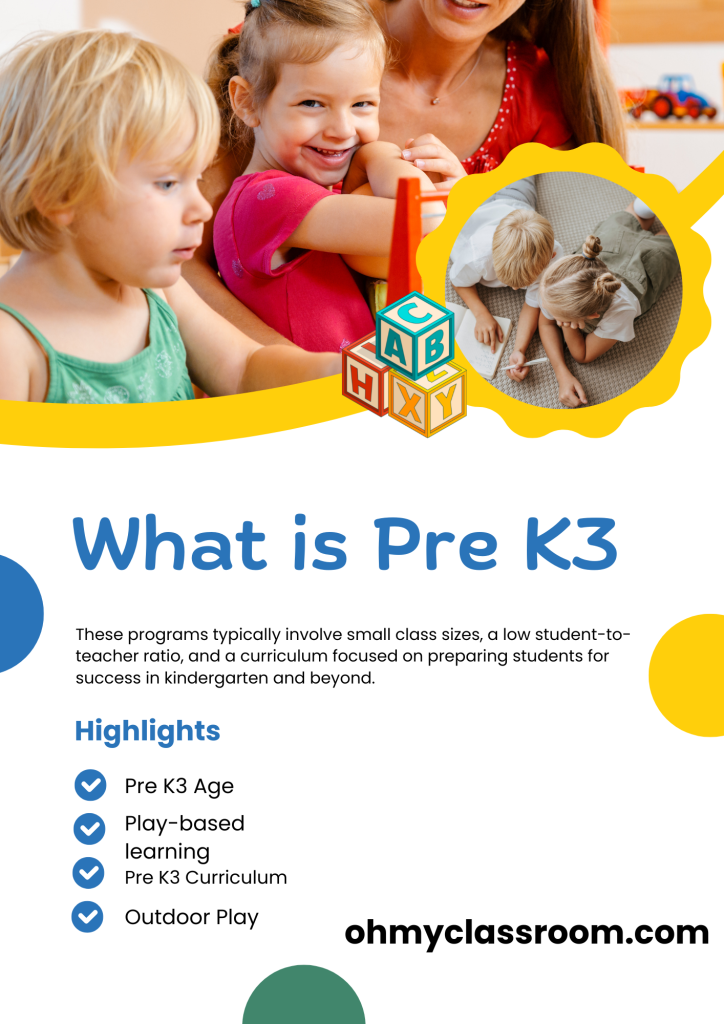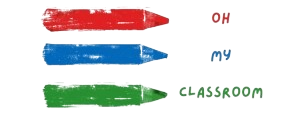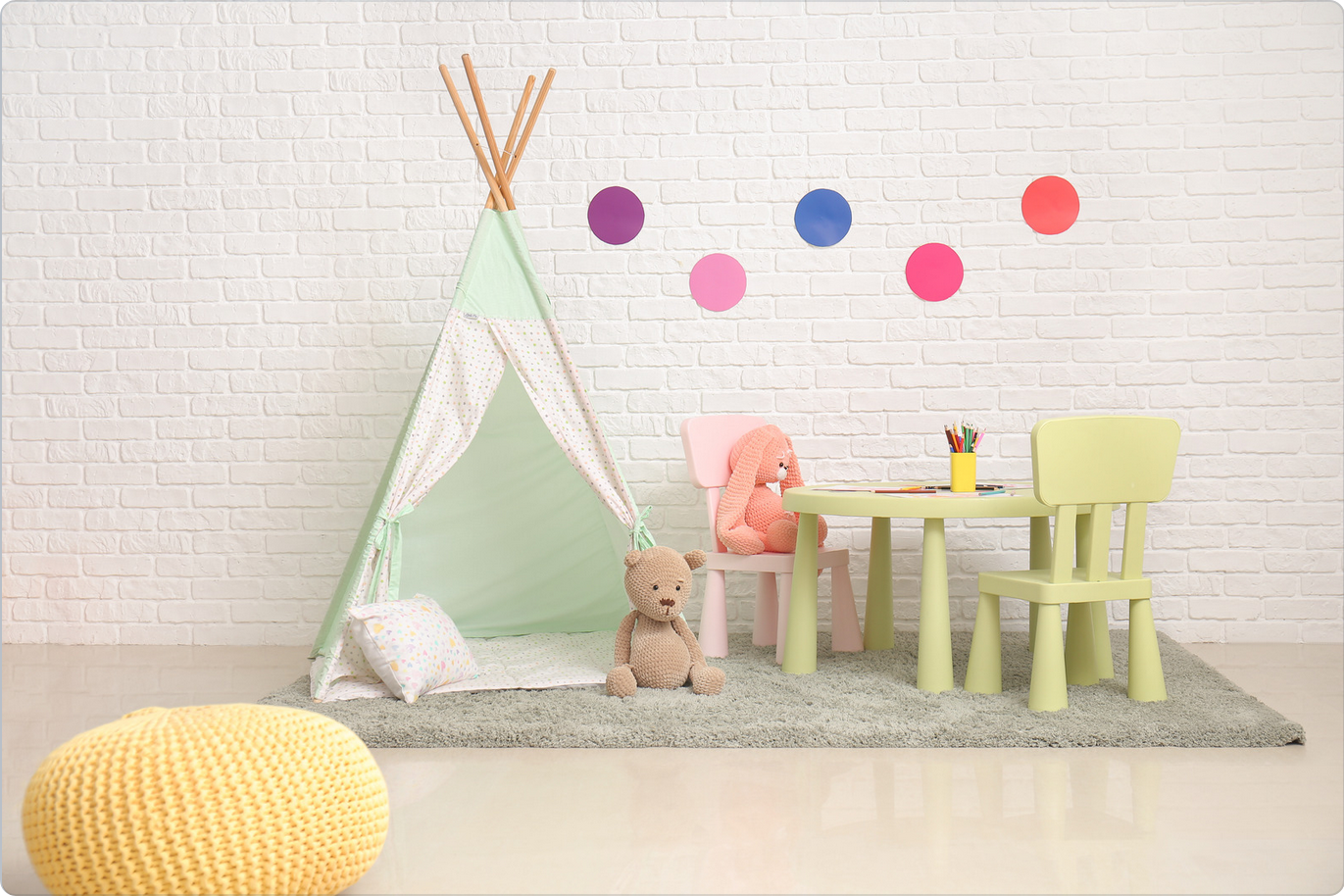Pre-K 3 programs are designed to provide a high-quality, research-based educational experience for three-year-old children or lower (in some cases).
So What is Pre K3 exactly?
Pre-K3, often referred to as “Preschool 3,” is an early childhood education program designed for children who are three years old.
It is a precursor to traditional pre-kindergarten or preschool programs and is aimed at providing young children with a structured and developmentally appropriate learning environment before they enter formal schooling.
In many cases, Pre-K 3 programs also include wraparound services such as health and wellness screenings, family engagement activities, and social-emotional support.
Pre-K 3 programs have improved school readiness, reduced the achievement gap, and increased high school graduation rates.

Related : How much does Pre-K cost?, Is Preschool and Pre-K the same thing?
[convertkit form=5575894]
What is the meaning of PK 3?
PK 3 stands for “Preschool 3.” It refers to an early childhood education program designed for children who are three years old.
It’s an age-specific program that provides young children with a structured and developmentally appropriate learning environment to prepare them for future education.
Is K3 a grade?
K3 typically refers to “Kindergarten 3,” which is not a universally recognized grade level. In some educational systems, Kindergarten is divided into two years, often called K3 and K4, or Pre-K and Kindergarten.
However, this terminology can vary depending on the educational institution or region.
Difference between Prek3 and Prek4
The terms “Pre-K3” and “Pre-K4” refer to specific stages in early childhood education. Here’s how they differ:
Pre-K3 (Preschool 3): For three-year-olds, focuses on basic social and cognitive skills introduction.
Pre-K4 (Preschool 4): For four-year-olds, builds on Pre-K3, introducing more advanced concepts for better kindergarten readiness.
Related : 50 Preschool vs No Preschool Statistics 2023
What Age is Pre K 3
There is no standard definition for pre-kindergarten (pre-k) age 3, but most programs serve 3- to 5-year-olds.
Some states have public pre-k programs that are part of the elementary school system, while other states provide funding for private pre-k programs.
Some programs may operate year-round, while others may only be offered during the school year.
The curriculum and activities offered in pre-k programs vary depending on the program’s goals and philosophies.
Still, most programs focus on preparing children for kindergarten by teaching them basic skills such as literacy, numeracy, and social and emotional development.
Related: What Age is Preschool and Kindergarten?
Source : https://www.victorybaptistschool.org/explore-3/pre-school-pre-kindergarten/
Pre K 3 Curriculum
A well-rounded pre k 3 curriculum should cover a broad range of topics, including language arts, mathematics, science, and social studies.
While each of these subject areas is important in its own right, they also build off of one another, providing a foundation for later learning.
For example, early math skills lay the groundwork for success in more advanced math courses.
Likewise, exposure to science and social studies concepts helps to develop critical thinking skills.
By providing comprehensive education, pre k 3 programs set children on the path to success in school and beyond.
Related: Why is Preschool Important?
Math
A pre k 3 maths curriculum should provide a strong foundation for future success in mathematics.
The curriculum should focus on developing numeracy skills, such as counting, sorting, and recognizing numbers.
In addition, the curriculum should introduce basic concepts of geometry, measurement, and probability.
By teaching these essential skills early on, pre k 3 maths programs can help to prepare children for the rigors of primary school maths. In turn, this can lead to better grades and a greater overall understanding of the subject.
Consequently, a pre k 3 maths curriculum is an important part of ensuring that children have the best possible chance of success in mathematics.
Arts & Crafts
The pre k 3 Arts & Crafts curriculum is designed to give students a foundation in the visual arts.
Through a variety of hands-on activities, students will explore the basic elements of art, including line, color, and shape.
In addition, they will learn about composition and design principles, and how to apply them in their own artwork.
As they progress through the curriculum, students will have the opportunity to experiment with different mediums, such as painting, sculpture, and collage.
By the end of the pre k 3 program, students will have a strong foundation in the visual arts and will be well prepared to continue their studies in higher-level classes.
Reading
The National Institute for Early Education Research has developed a Pre-K 3 Reading Curriculum Framework to support educators in planning and implementing high-quality reading instruction for young children.
The Pre-K 3 Reading Curriculum Framework is based on the latest research on early literacy development and provides guidance on the essential components of a comprehensive reading curriculum for young children.
Related: Effective Tips to Improve your Reading Comprehension Skills
The Framework includes three main components: (1) print knowledge and concepts, (2)phonological awareness, and (3) oral language. Each of these components is described in detail below.
Print knowledge and concepts involve young children’s understanding of the features of print and their ability to use this knowledge to engage with texts.
Phonological awareness is the ability to notice, think about, and manipulate the sounds in spoken language.
Oral language refers to the ability to understand and use spoken language for a variety of purposes.
The Pre-K 3 Reading Curriculum Framework provides guidance on how to teach these essential components of reading through a variety of instructional activities and strategies.
Dramatic Play
The pre k 3 Dramatic Play curriculum is designed to help young children develop important social and cognitive skills.
Through imaginative play, children learn to explore their emotions and express themselves in creative ways.
They also learn to cooperate with others and take on different roles in a group.
The curriculum includes a variety of activities and games that facilitate these kinds of learning experiences.
For example, children might pretend to be different animals in a farm setting or act out a familiar story such as Goldilocks and the Three Bears.
By engaging in such activities on a regular basis, pre k 3 students will develop the essential skills they need to succeed in school and in life.
Conclusion
If you are looking for a program that will help your child get ready for kindergarten and beyond, consider a Pre-K 3 program.
These programs have been shown to be beneficial for students, and they often include wraparound services that can support the whole family.


